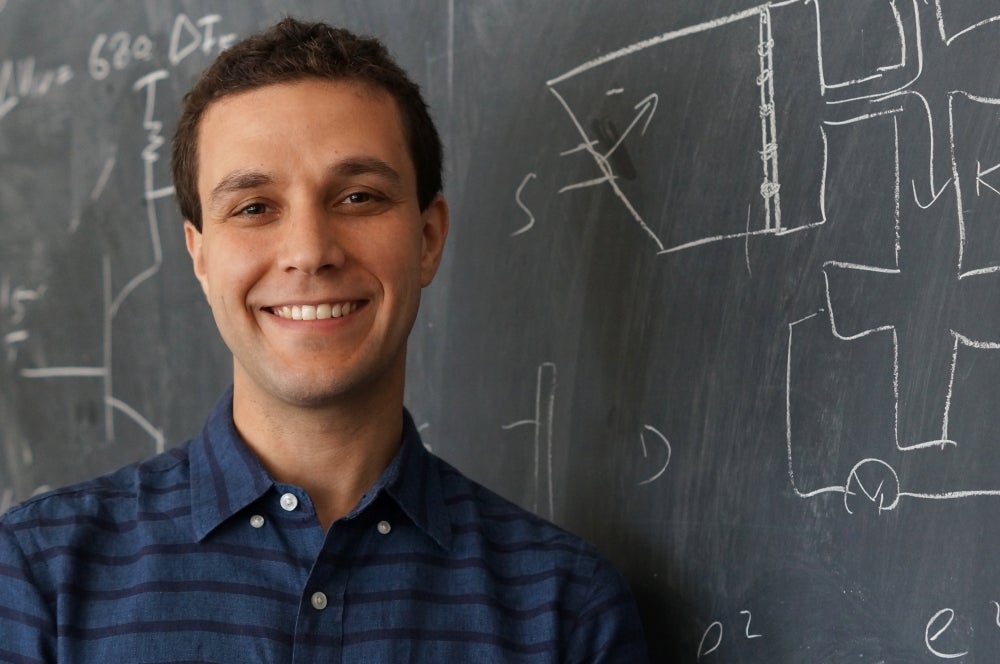
A Junior Laureate
UC Santa Barbara assistant physics professor Andrea Young has been named a winner of the Milner Foundation’s 2018 New Horizons Prize in Fundamental Physics. Young is one of three junior researchers to be honored for their important contributions to the field of physics early in their careers. Young, who was cited for “the co-invention of van der Waals heterostructures, and for the new quantum Hall phases that he discovered with them,” is joined by Ohio State’s Christopher Hirata and Douglas Stanford from the Institute for Advanced Study and Stanford University, each receiving a $100,000 prize in recognition of their work.
“It has been my great fortune to have been able to contribute something to condensed matter physics and I am delighted to share this recognition with UCSB, which has been a wonderful scientific and intellectual environment,” Young said. “I owe a great deal to my collaborators and the dedicated students and postdocs in my research group — we are just beginning to understand what van der Waals heterostructures can teach us about two-dimensional physics, and I am excited for what the future holds.”
“Professor Young’s selection for the New Horizons Prize is a proud moment for him and our UC Santa Barbara campus,” said Chancellor Henry T. Yang. “This award is a prestigious recognition of his promise as a young researcher and his high-caliber work at the cutting edge of condensed matter physics.”
Yang added, “As the recipient of several early-career awards, Andrea has a bright future ahead and we look forward to continuing to support his scientific pursuits.”
Young joined the UCSB faculty in 2015. He brought with him expertise in the use of the remarkable, two-dimensional material graphene and an eagerness to explore its properties. At only a single carbon atom thick, graphene can be very difficult to work with — it wrinkles easily and is readily influenced by its environment — but it also is 100 times stronger than steel, impermeable and transparent. And it has valuable electronic properties that makes it a promising material to study.
Young’s work has had impacts in both the fundamental and applied areas of physics. Among his most notable early accomplishments is the use of hexagonal boron nitride (hBN) as an ideal scaffold for graphene, an advance he and colleagues at Columbia University developed in 2010 when Young was a graduate student. Other substrates being used prior to hBN were prone to surface irregularities and other imperfections that would interfere with graphene’s performance. The research from that 2010 paper has been cited more than 3,000 times.
“The New Horizons Prize is given to early-career researchers whose efforts already show great potential,” said UCSB physics professor and Vice Chancellor of Research Joe Incandela. “Even at this stage in his career, Andrea’s research has already influenced a wide spectrum of scientists, from those conducting fundamental physics investigations to those exploring the material applications of graphene in electronics.”
Since Young’s 2010 paper, the study of layering two-dimensional materials — known as van der Waals heterostructures, for the forces that interact between the atoms of each layer — has boomed, as scientists have isolated other 2D materials and investigated the cumulative effects of stacking and orienting such materials. Using graphene and hBN, Young’s research group illustrated this concept in 2013. Their experiment resulted in the direct observation of Hofstadter’s butterfly, a fractal phenomenon predicted in 1976 by physicist Douglas Hofstadter for the motion of electrons under a strong magnetic field. Young’s group was one of three that were able to generate the butterfly using van der Waals heterostructures.
At UCSB, Young continues his work with graphene, using the fine control of the devices his research group has developed to pursue non-Abelian anyons — collective excitations or “quasiparticles” predicted to occur in two-dimensional systems. The early results have been promising: States consistent with these non-Abelian anyons have been observed in their device, which, if conclusively proven, can lead to advances in topological quantum computing, for example. Non-Abelian anyons are particularly important because of their predicted ability to protect information from decoherence — a major challenge for anyone building a quantum computer.
Advances in van der Waals heterostructures pioneered by the Young Group allow these anyonic states to be realized more robustly, bringing experiments into a much more convenient temperature range (quantum systems are typically held at near-absolute zero temperatures to suppress undesired thermal fluctuations). That, in turn, could further enable both the study of fundamental physics of quantum entanglement and the ultimate development of a topological quantum bit (or “qubit”) — the basic element of a quantum computer.



